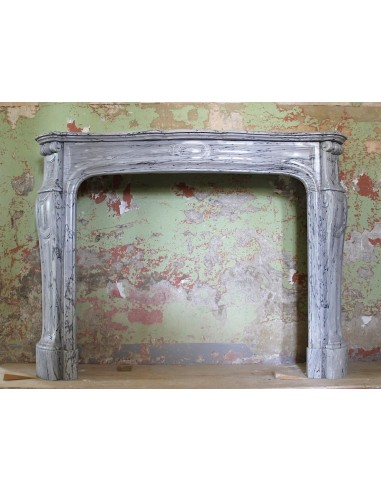In my opinion, in order to best enjoy this particular and rare* Pompadour Pied Galbé it will be necessary to deepen our knowledge of the fascinating Bleu Fleuri marble with which it was carved.
Of course, it is only fair (Let us give Caesar his due) to call this fireplace “Parisian,” if only because of its very recognizable stylism that is precisely Parisian, both because of its having been disassembled from a Parisian palace and, why not, also because of the fascinating name of its marble, evocative of serene night skies and intriguing amorous stories, a name that the architects of the Ateliers des Arts had coined, however, it must be said that this fireplace also has a lot of Italian in it, since, in fact, this stone material had a French name but was quarried from the Apuan Alps and in Italy originated under the name “Bardiglio” (from the Spanish “Pardillo” which stands for “Grigio”). “But how?” you will ask (ask me or I cannot continue my comment, Thank you..). “But if you wrote in the title that his marble is called Bleu Fleuri!!! What are you doing, getting confused!”
But no, I am not getting confused, just have a little patience and you will understand....
You should know that Bardiglio, a marble quarried in the Apuan Alps, was considered in Italy mostly good for making floors (because of its excellent strength and texture), floors in which it was very often combined, with checkerboard laying, with Carrara White marble.
In many residences, including aristocratic ones (e.g., in several Medici villas), Tuscan and Ligurian especially, it will be possible to find floors of this style.
But very rarely was our Bardiglio, poor duckling, taken to the glories of decorative sculpture.
And so it was the French, unbeatable in adding value to the objects of their trade (see wines, they sell them at exactly three times the equivalent Italian wines, or cosmetics or handbags even scarves... here better to draw a pious veil, and so on...) and so, I was saying, it was the French who understood the qualities, intrinsic and evocative, of this particular marble, after all it would have been enough to change its name to make a lucrative trade out of it.
Thus it was that our Bardiglio, from an ugly duckling became the beautiful swan Bleu Fleuri, soon commercialized and appreciated throughout the Western world.
What I have written above has a moral: It is not that the French only “well marketed” or “cleverly marketed” this very Italic marble, the latter already possessed in itself a wealth of qualitative (compactness and strength) and aesthetic (shades, precisely, turquoise, very rare to be found in other stone materials) characteristics, one only had to notice it.
Parisian provenance, period second half of the 19th century, very Italian sculptural quality, since it was carved in a workshop in Lunigiana, an area where the best sculpture on the globe was expressed, perfect preservation and superb patina.
* Rare in that the vast majority of fireplace mantels belonging to the Pompadour family were carved from White Carrara marble. Only about 10% were made in colored marble, and of this 10% only a very small fraction were “dressed” in this fascinating marble.






























































